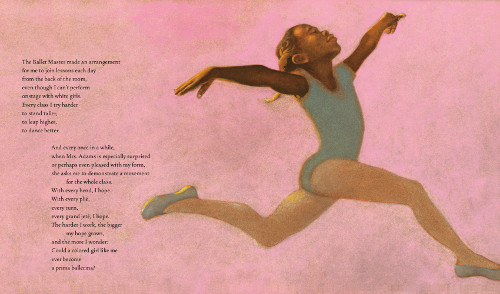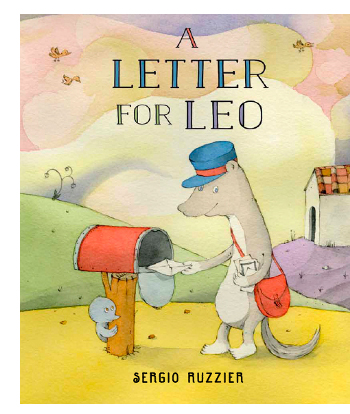My Chapter 16 chat with G. Neri …
 Monday, November 17th, 2014
Monday, November 17th, 2014

Over at Chapter 16 today, I talk with author G. Neri about his new picture book biography, Hello, I’m Johnny Cash, illustrated by A. G. Ford.
That Q&A is here.
 Monday, November 17th, 2014
Monday, November 17th, 2014

Over at Chapter 16 today, I talk with author G. Neri about his new picture book biography, Hello, I’m Johnny Cash, illustrated by A. G. Ford.
That Q&A is here.
 Sunday, November 16th, 2014
Sunday, November 16th, 2014
The review is here, so you can head over there if you want more information. This morning, I share two spreads so that we can all get a sneak peek inside the book. One more is below.
 Friday, November 14th, 2014
Friday, November 14th, 2014

every grand jeté, I hope. …”
(Click to enlarge spread and see rest of text)
This morning over at Kirkus, I write about Russell Hoban’s Jim’s Lion. It’s been re-imagined as a graphic novel with the illustrations of Alexis Deacon. That link is here.
Last week, I wrote here about Kristy Dempsey’s A Dance Like Starlight: One Ballerina’s Dream, illustrated by Floyd Cooper. Today, I’ve got some spreads from the book.
Enjoy.
 Friday, November 14th, 2014
Friday, November 14th, 2014


 As you can see, I’m doing something totally different today.
As you can see, I’m doing something totally different today.
That’s the cartoonized version of me up there, interviewing the two main characters of an upcoming graphic novel for children, called Hippopotamister. Springing from the mind of comics creator John Green (pictured right), who lives in Brooklyn and is best known for Teen Boat, his collaboration with Dave Roman, Hippopotamister is Green’s solo debut. It’s a comic geared at younger children and tells the story of Hippo and his friend, Red Panda. They live in the city zoo but head out to get jobs in the bustling world of humans. (Hippo becomes the titular Hippopotamister — just to survive out in the big city.) Red Panda finds the occupational world challenging, and even though Hippo excels at each job he secures, Red Panda manages to get them fired. The book is scheduled for an early-2016 release from First Second.
You can read a great process essay from John here at School Library Journal, as well as this interview at The Beat. (P.S. Mr. Schu got cartoonized, too.)
I thank John for visiting. This makes the second time I’ve interviewed wise-crackin’ animals. (Punk Farm was my first.)
Art is copyright © 2014 by John Green and used by his permission.
Photo of John Green taken by Ellen B. Wright.
 Thursday, November 13th, 2014
Thursday, November 13th, 2014

Over at Kirkus this morning, I’ve got a Q&A with author Heidi Schulz, whose debut novel, Hook’s Revenge, arrived on shelves in September from Disney-Hyperion.
The book includes cover art and interior illustrations from John Hendrix. Next week here at 7-Imp, I’ll have some art from the book.
The Q&A is here.
Until tomorrow …
 Tuesday, November 11th, 2014
Tuesday, November 11th, 2014
 It’s such a pleasure to have printmaker and illustrator Rick Allen visit 7-Imp this morning, especially to read his thoughtful responses to my questions below — and, of course, to see his compelling prints as well.
It’s such a pleasure to have printmaker and illustrator Rick Allen visit 7-Imp this morning, especially to read his thoughtful responses to my questions below — and, of course, to see his compelling prints as well.
Rick is up in cold, windy Minnesota in a city on Lake Superior’s north shore, and as you’ll read below, it’s just the right place for him to be. His first book was self-published via Kenspeckle Letterpress, which he describes as “original letterpress artwork, giclees, notecards, prints and posters…[with] his creative muse: Marian Lansky.” His other two books were published by Houghton Mifflin Harcourt and written by award-winning children’s book author and poet Joyce Sidman. The first, Dark Emperor & Other Poems of The Night, received a 2011 Newbery Honor. And I wrote here at Kirkus about their latest collaboration, Winter Bees & Other Poems of The Cold, released just last week. Allen’s illustrations for each are exquisite.
For our fake cyber-breakfast, which I very much wish were real and in-person, Rick’s going to be brave and go for coffee. “Breakfast,” he told me, “is multiple cups of tea, usually black tea of varying strength, depending upon how long I forget it’s been steeping (credit chris). In the last few years, I’ve been experimenting with drinking coffee in the morning; to make it palatable I generally lash in great quantities of half-and-half, so perhaps it’s coffee-tinted cream that I’m drinking. We had a Swedish great-grandmother, who used to slurp coffee from a saucer into my siblings and me when we were just months old, and it may have taken a half-century to overcome that early cultural conditioning to try coffee, or near-coffee, again.”
I can always help people find their way to coffee!
I thank him for visiting. Read the rest of this entry �
 Sunday, November 9th, 2014
Sunday, November 9th, 2014

 We’re goin’ Grimm today, you all.
We’re goin’ Grimm today, you all.
Back in September, Minedition (whose books I’m always eager to see) released a picture book adaptation of the Grimms’ tale “The Wolf and the Seven Young Kids” with illustrations from Keiko Kaichi. The Wolf & the Seven Kids was translated by Anthea Bell and is very faithful to the Grimms’ version, viciousness and all. And this is the debut book from Kaichi, who was born and raised in Japan and who currently lives in Osaka.
Kaichi’s kids, the baby goats, are clearly snuggly and … well, flat-out adorable, as you can see here. But the book doesn’t shy from the original tale’s dramatic turn-of-events. The wolf still eats every kid but one, and the mama still releases the six from the wolf’s stomach with her scissors, needle, and thread. Oh, and that’s right: The big bad wolf also still sees his demise at the bottom of a well.
This has always been one of the most terrifying Grimms’ tales to me. An intruder bursts into the home and kidnaps, then devours, each and every kid — but one. The one who manages to hide and hear the entire thing. Oof. This makes it all the more satisfying when the mama comes home to save everyone. With her SEWING KIT, nonetheless! And then she distributes very tight hugs.
Kaichi’s color palette is particularly soothing, but I’ll let you see for yourself with some more art below.
 Friday, November 7th, 2014
Friday, November 7th, 2014

This morning over at Kirkus, I write about Kristy Dempsey’s A Dance Like Starlight, illustrated by Floyd Cooper. It was released back in January, but sometimes I’m just slow. That link is here.
The other day over at Chapter 16, I interviewed Chris Van Allsburg. He’ll be in Nashville next week. I can’t make it to his talk, but it was good to ask him a bit about his new book and what’s next for him.
And over at BookPage, I reviewed Jim Aylesworth’s My Grandfather’s Coat, illustrated by Barbara McClintock. That is here.
Last week (here) at Kirkus, I wrote about four new international imports, and I’ve got art from each below. (Above is an illustration from Kazue Takahashi’s Kuma-Kuma Chan, The Little Bear.)
 Thursday, November 6th, 2014
Thursday, November 6th, 2014

… I still have some spine-tingling art to share here at 7-Imp today.
Last week, I chatted here with author James Preller over at Kirkus. We chatted about several things, including his Scary Tales series (Feiwel & Friends), which are illustrated by Iacopo Bruno.
Today, I’ve got some of Bruno’s art from the Scary Tale books. (Pictured above is an illustration from One-Eyed Doll, the newest in the series.)
 Wednesday, November 5th, 2014
Wednesday, November 5th, 2014

 This morning, I’m talking to author-illustrator Sergio Ruzzier about his newest picture book, just released yesterday, called A Letter for Leo (Clarion, November 2014). Sergio also shares a bit of art and early sketches from the book.
This morning, I’m talking to author-illustrator Sergio Ruzzier about his newest picture book, just released yesterday, called A Letter for Leo (Clarion, November 2014). Sergio also shares a bit of art and early sketches from the book.
This is the story of Leo, a mail carrier who longs to get a letter himself. One morning, he finds a little blue bird, who pops out of a mailbox, in need of a home. The two become good friends, the bird even staying with Leo in his house. Since the bird’s response to everything is “cheep,” this is what Leo names him. Leo and Cheep become “a little family.”
But when Spring arrives, flocks of birds fly north. Cheep is ready to go too. There is a poignant goodbye (involving a “cheep” from Cheep and a “cheep” from Leo). Life goes back to what it was pre-Cheep, but Leo finally gets a letter. Cheep has written, and it’s my favorite picture book ending of 2014. The first time I read it with my own daughters we laughed and laughed, because the letter is composed entirely of “cheep”s.
Also, Cheep may or may not return to visit Leo, but I’ll leave that for you to discover on your own if you find a copy of this book.
Stories about friends coming and going — it’s a common theme in picture books, but no one does it quite like Ruzzier, given his lively, singular style and the rich visual narratives he creates. Booklist calls this one a “sweet, understated story set amid a wonderfully odd landscape.” I love that. This is a story both tender and laugh-outloud funny; Sergio pulls it off with ease — and with characters who leap off the page. Esther Averill once wrote that the “final test for any child’s book” is whether it can be “placed alongside the best for adults and hold its own.” I think Sergio’s books can.
Let’s get to it. I thank him for visiting today. Read the rest of this entry �